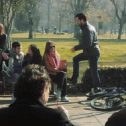"A documentary on extreme amusement park rides and their effects on the brain."
The Centrifuge Brain Project is a documentary short directed by German artist Till Nowak that portrays “caricatures of civilization”, amusement rides that people willingly take in order to be centrifuged. Till Nowak, founder of Framebox studio and disciple of Chaplin’s subversive humor, takes a look at the follies of modern society in this mockumentary that skillfully mixes computer graphics (CG) with filmed footage.
It was never my intention to make people really believe that this was real
Coming from a digital arts background with a number of previous works made in 3D animation and others combining 3D with filmed footage, Till has taken the live filmmaking route while still making great use of CG to potentiate the story.
Analysis: First Look
Humor permeates this purported scientific documentary, which is presented in the most deadpan, poker-faced way. The documentary’s style follows what is usually called the “expository mode”, the type of documentary that aims to inform viewers using interviews and various kinds of evidence to support its argument.
In this case, however, the information passed on to the viewers is complete nonsense. But it’s delivered in the most realistic way, complemented with footage that “proves” that the rides exist.
Till Nowak’s intention was to make the film look realistic, but not to make people actually believe that the amusement rides existed. He was quite surprised to find out many people believed the film was real. Still, this was the case, and it shows that he was very successful at building a convincing façade. In this analysis we’ll focus on the film techniques he used to build and maintain this façade.
Shot Types and Camera Elements
The Centrifuge Brain Project uses many medium and close-up shots, which are used to frame Dr. Nick Laslowicz’ interview. These are usually stable and filmed with a tripod. The subject is filmed from an angle, not frontally, which is standard practice in documentary filmmaking and projects a degree of emotional detachment. Wide shots are employed during park rides to cover the action.
Camera height is usually at eye level or that of a human and seldom leaves the ground. Rides are shot from below, from the position of an observer.
Camera Moves
Here we find one of the elements that is used to transmit a feeling of authenticity: handheld camera moves are used most explicitly in the amusement ride sequences, with the aim of showing that the footage was shot on site by an amateur.
These contrast with the smoother camera moves during Dr. Laslowicz’ interview, in which the camera is mostly static with some occasional slow-paced pans. When Dr. Laslowicz is not seating a handheld camera is used to follow his actions, but it’s far more restrained than the shots of the rides (this is usually the case also when the subject is walking around amusement parks).
Editing & Continuity
At an average shot length of 5.2 seconds the average editing pace is slower than current filmmaking standards and uses cuts with just a few fades.
In this number we find a hint of another element used to transmit authenticity: the editing pace of the film isn’t slow, the average number makes it slower because most of the amusement rides’ sequences are usually longer, and they usually don’t feature cuts with varying shot sizes. This, coupled with the coarse camera movements and the characteristic consumer camera aesthetic help transmit the sensation of an amateurish camera.
The amusement rides’ sequences themselves may not feel slow paced because the visual rhythm remains high, thanks to the fast movement of the rides and the camera following them.
On a more macro view, the editing strategy is designed to make viewers believe they are watching a common documentary with a scientific theme. Editing is driven by Dr. Laslowicz’ speech, alternating mainly between two thematic lines, the sequences of the interview (or of the subject portrayed in different situations) and those of the rides, complemented by various illustrative material such as old footage, photos, graphics, etc. This also helps develop a progression in time showing the different rides and experiments developed.
Mise-en-Scène
Set in an urban environment, the whole staging is designed to create a scientific documentary façade. The “Institute for Centrifugal Research” building successfully transmits the image of an old research institute with its spacious rooms populated with desks, racks, old PCs, machines and blackboards.
Also contributing to the scientific documentary image are the way actor Leslie Barany is dressed (his researcher costume) and the props he uses.
Here we find two other key elements that help build the façade: Barany’s great acting performance and the monologue he delivers, which is filled with subdued humor and technical words. The actor uses a naturalistic acting style for delivering the lines, transmitting emotions without being overly histrionic and showing through these emotions that he is more concerned about the outcome of the experiments than about the people taking part in them. He also conveys the feeling that he is indeed recollecting events while he is talking about them.
Image & Aesthetic
Here we find another key aspect for achieving the verisimilitude of The Centrifuge Brain Project: its CG amusement rides. These are modeled, animated and composed seamlessly with filmed footage, and they also fit perfectly well with the camera movements that are supposed to be following their action. The CG rides are crucial for making the film work, and have been given a prominent role in the documentary (though they were originally made for Till Nowak’s previous “The Experience of Fliehkraft” art project).
The aesthetic of the image also changes in the park ride sequences, using various post processing effects to make it look more desaturated and blurred, with automatic exposure at work, mimicking the behavior and image of a consumer camera. The aspect ratio also follows this same purpose.
It’s worth noting that this outstanding CG and camera tracking work has been done by Till Nowak himself.
Sound
Complementing the above, sound plays a very important part in helping create the illusion of the CG rides. The ambiance of the theme parks is recreated using appropriate music, along with the sound of the crowds and the screams from the people taking the rides. The screams are carefully synchronized with the CG rides to help make the VFX believable.
Conclusion
Till Nowak’s intention when building these outrageous imaginary park rides was to exaggerate the characteristics of current rides to make people see once again the irrationality of the reality around them, helping reveal something that is no longer perceived due to us having adapted to it. His artwork plays with established norms of society and culture.
In The Centrifuge Brain Project he chose to approach the subject with humor, building a scientific documentary façade using various elements, including codes from expository documentaries, a fun dialogue filled with technical jargon, great naturalistic acting and believable footage of imaginary amusement rides created with CG.
If this wasn’t enough, he also extended this façade to the the net. He created a website for the Institute for Centrifugal Research, which prominently features the slogan “Gravity is a mistake. We work hard to correct it.”
The proof that the director succeeded in the realistic documentary approach can be found easily in the amount of comments on the net asking if the rides are real. From the film one can tell that he had a lot of fun working on this project. And he certainly managed to make us look at amusement rides in a different light.
Don’t miss
Interview – Till Nowak on the making of The Centrifuge Brain Project
Link
Outtake - Dr. Laslowicz about the early days
Link
Outtake - Dr. Laslowicz about High Altitude Conveyance System
Link
Outtake - Dr. Laslowicz about Centrifugalization
Link
Unusual incident: windows crossing the street
Link
Framebox - Till Nowak's production studio
Link






















Recent Comments